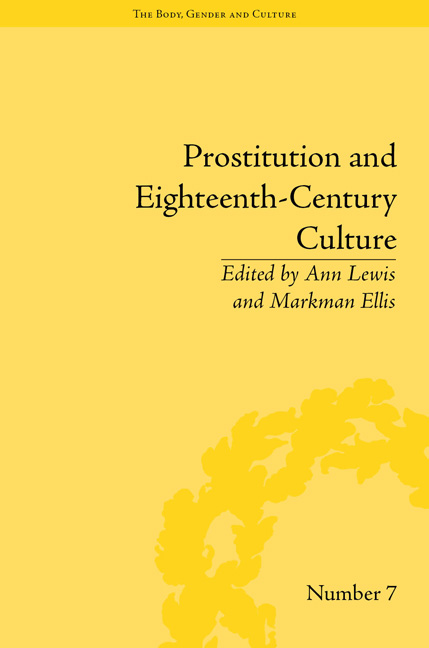Book contents
- Frontmatter
- CONTENTS
- Acknowledgements
- List of Contributors
- List of Figures and Tables
- Introduction: Venal Bodies – Prostitutes and Eighteenth-Century Culture
- Part I (Auto)Biographical and Classificatory Fictions: Madams, Courtesans, Whores
- Part II Visibility and Theatricality: Fiction, Image and Performance
- Part III The Magdalen House: Marriage, Motherhood, Social Reintegration
- 10 Figuring the London Magdalen House: Mercantilist Hospital, Sentimental Asylum or Proto-Evangelical Penitentiary?
- 11 Mothers and Others: Sexuality and Maternity in The Histories of Some of The Penitents in the Magdalen-House (1760)
- Part IV Wider Perspectives: Constructing the Prostitute in Social History
- Notes
- Index
10 - Figuring the London Magdalen House: Mercantilist Hospital, Sentimental Asylum or Proto-Evangelical Penitentiary?
from Part III - The Magdalen House: Marriage, Motherhood, Social Reintegration
- Frontmatter
- CONTENTS
- Acknowledgements
- List of Contributors
- List of Figures and Tables
- Introduction: Venal Bodies – Prostitutes and Eighteenth-Century Culture
- Part I (Auto)Biographical and Classificatory Fictions: Madams, Courtesans, Whores
- Part II Visibility and Theatricality: Fiction, Image and Performance
- Part III The Magdalen House: Marriage, Motherhood, Social Reintegration
- 10 Figuring the London Magdalen House: Mercantilist Hospital, Sentimental Asylum or Proto-Evangelical Penitentiary?
- 11 Mothers and Others: Sexuality and Maternity in The Histories of Some of The Penitents in the Magdalen-House (1760)
- Part IV Wider Perspectives: Constructing the Prostitute in Social History
- Notes
- Index
Summary
When the London Magdalen Hospital for Penitent Prostitutes first opened its doors in August 1758, the institution was a striking novelty. Jonas Hanway, founding father and well-known social reformer, spoke for the more general public response to the project when he stated that ‘no subject, has come before us, for a long time, so new as this, and yet so interesting’. The institution's distinctiveness lay in its commitment to the idea that prostitutes were victims of their situation, and were reformable. The novelty of this reform agenda was evident from William Dodd's inaugural sermon in the Magdalen Hospital chapel, where he described how the charity had met with ridicule on the grounds that reforming prostitutes was a ‘scheme to wash Aethiopians white’. The founders of the London Magdalen Hospital, drawing on the continental Catholic tradition of Magdalen homes for reformed prostitutes, instituted a signal transformation of the figure of the prostitute in British culture. From vilified agent of moral and social contamination, the prostitute had become a virtuous and recuperable victim of circumstance.
The new representation of the prostitute had been gaining currency in sentimental and charitable literature over the previous decades, but it is clear that the practical commitment to the idea which the establishment of a Magdalen Hospital represented and the great support which it went on to enjoy from the polite public in the following decades marked a radical cultural shift. What is not quite so clear is how to interpret this shift.
- Type
- Chapter
- Information
- Prostitution and Eighteenth-Century CultureSex, Commerce and Morality, pp. 141 - 156Publisher: Pickering & ChattoFirst published in: 2014



